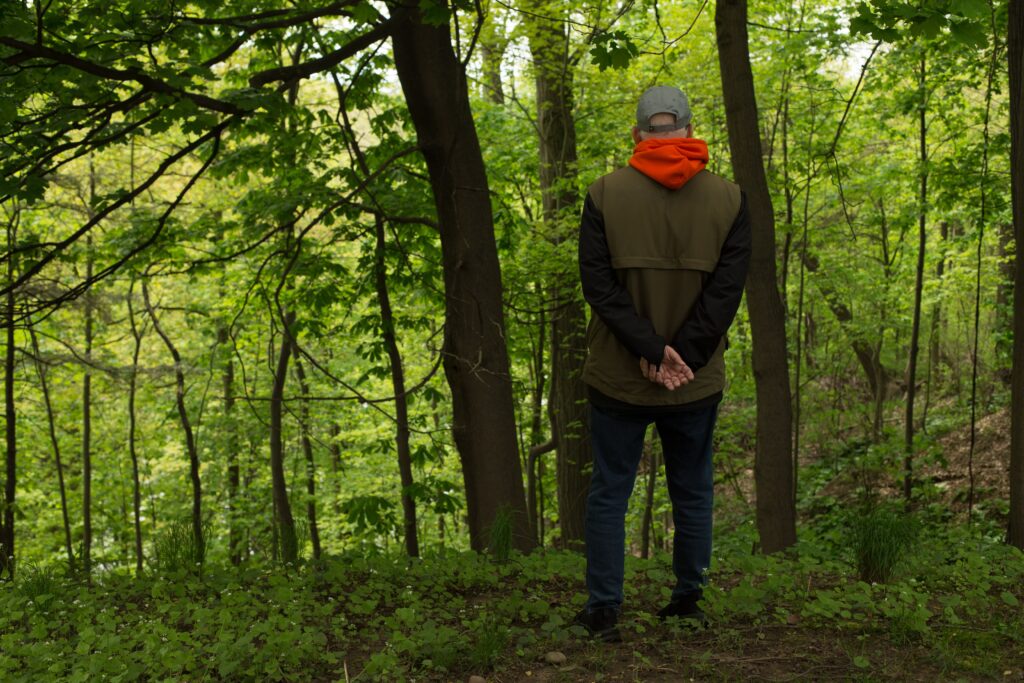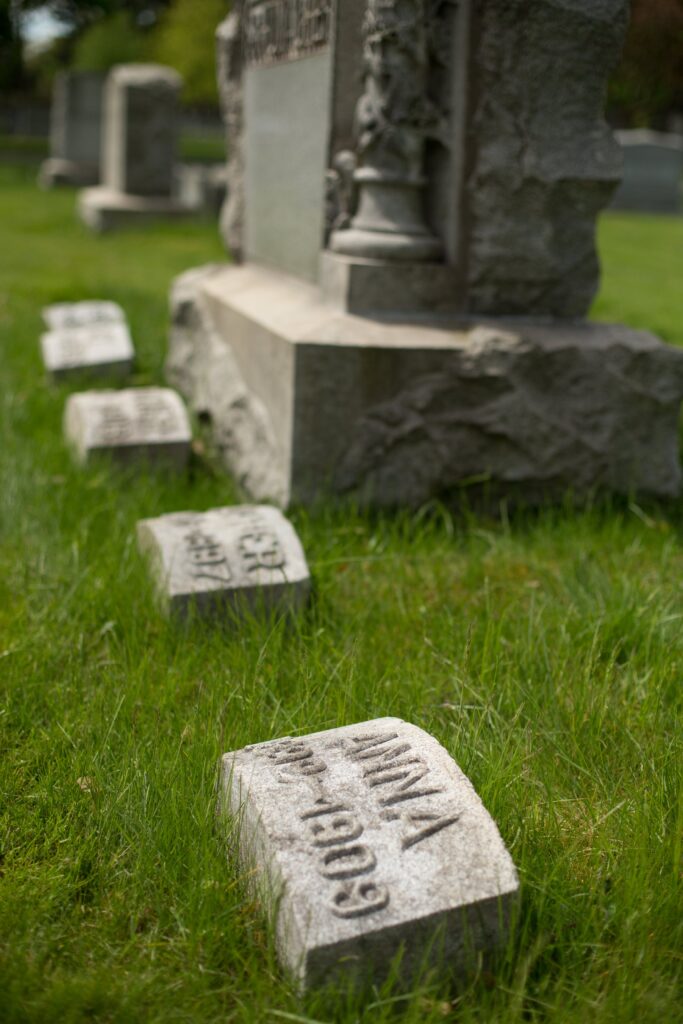
Saturday, August 7, 1909, 1 p.m., temperature 92 degrees, humidity uncomfortable. Sixteen-year-old Anna Catherine Schumacher left her home at 162 Cady Street, her mission to groom and place sweet peas and nasturtiums from the flower garden behind her family home upon the graves of her father and sister in Holy Sepulchre Cemetery. Anna walked to a streetcar stop where she caught a Jefferson Avenue car downtown. At the Four Corners she transferred to a Charlotte car that took her to the cemetery. We know she did this because a family friend, a Mrs. Graham, saw Anna get off at the cemetery.
After that, we don’t know.
When Anna did not return on Saturday night, her mother called police at the Bronson Avenue station and reported her missing. Very little attention was paid to the report. Anna’s sister later recalled, “My mother and I went to the Sixth Precinct and told the officer who was there that my sister was missing.”
“Humph!” the officer replied. “There are a lot of girls out as late as this.”
The women looked at the clock on the wall. It was 10:40 p.m. Anna had been gone for less than ten hours.
“How old is she?” the cop asked.
“Sixteen,” Mrs. Schumacher said. And then, after a pause, “Almost seventeen.”
“Is she accustomed to being alone at this time of night?” the policeman asked.
The question greatly upset the women. “We were so disgusted, we walked right out,” the sister recalled. “We went home, fetched lanterns, and drove a carriage to the cemetery to look for Anna.”
There, he found evidence of Anna’s presence: fresh flowers at her father and sister’s graves. Plus, tufts of unsightly grass had been trimmed with the scissors she’d brought along.
On Sunday, they tried again. The women gathered the family plus some friends together and formed a search party. After another unsuccessful scouring of the cemetery, they split up and canvased the neighborhood asking if anyone had seen a teenaged girl.
One man, a stranger, answered his door and said he hadn’t seen Anna—but he offered a word of advice: “If I were in your place, I’d get Constable Stalhan Baker of Greece police. He won’t give up the search if he dies in the attempt. If he can’t find her, you might as well give up.” The advice turned out to be good.
Baker’s first question was, “How many times had Anna gone to that cemetery alone?” He was considering the possibility that she might have been using “flowers on the grave” as an excuse to meet a boy.
“This was the third time,” Anna’s brother John Schumacher replied. He then added, “She is not accustomed to being on the streets alone, she always went places with her older sisters, and she was not in the habit of being in the company of men.” The family was trying to get by without a father’s income, John explained, and so Anna had quit school at sixteen to work as a seamstress for the Michaels, Stern & Company’s factory on St. Paul Street, where one of her sisters was also employed.
First thing Monday morning, Baker grabbed colleague Otto Friedman, and John, and the three went to the cemetery. They spoke to a groundskeeper who remembered seeing the girl, at first in the section where she was decorating graves, and later all the way to the east, along the edge of the river gorge, perhaps picking wildflowers.
In the bushes along the gorge’s edge, Constable Baker followed a woodchuck scurrying away. Hampered by the thicket and low-hanging branches, Baker saw drag marks on the ground and then a patch of loose earth only feet from the cliff, the river 200 feet below.
“My God, Otto,” Baker said. “This looks like a newly made grave.”
The men had no shovels and began to dig at the loose dirt with their hands. After a few moments, a ribbon was unearthed, then a corner of a woman’s garment.
“We should stop right now and notify Sheriff Gillette and Coroner Kleindienst,” Baker suggested.

Within the hour the body of Anna Schumacher had been recovered. It lay face down with the feet doubled back so that it fit in a four-foot-long excavation. The left cheek was bruised, and there was a fresh cut over the left eye. She was covered with bruises, most severely on her chest. One breast was “black and discolored.” Eyewitnesses said that it was “obvious that she had been raped and murdered. The condition of the body indicated that the girl put up a stout battle for her honor and life.”
Though shallow and crudely constructed, the grave was interesting in that it had been dug with a shovel. The killer had access to a tool. It seemed to indicate that the fiend might be a cemetery insider.
The coroner made a quick inspection of the victim’s throat. “Hyoid bone is broken,” he said. This indicated manual strangulation. The body was taken to the morgue where an autopsy was performed by Dr. Donald L. Hazen of Brockport.
There was bloody froth found in the throat and trachea. Both lungs had collapsed. Death had come from suffocation. Particles were found under the victim’s fingernails that looked like human flesh. That meant the killer was visibly scratched. The bits of flesh were removed from under the victim’s nails and mounted on a glass slide to be examined under a microscope.
Interviews with the cemetery employees yielded another lead. Almost as soon as officials cleared the crime scene area, at four o’clock on Monday afternoon, a man was reportedly seen along the eastern edge by three employees.
One of them said, “He was alone, by where they found the girl, dressed in a blue suit and a straw hat. When he saw that he was being observed, he turned and headed toward Riverside Cemetery,” which was adjacent and to the north.
The suspicious man, they said, walked fast at first. Seeing that he was being followed, he broke into a trot, then a full-fledged run.
“We pursued as far as the border between the cemeteries, then returned to our offices where we told our boss what we saw,” they reported.
Their boss, cemetery superintendent John B. Meisch, notified police, and motorcycle officers searched Riverside Cemetery and the surrounding area without success. The suspicious man had vanished. Never to be found. If he ever existed. Investigators kept an open mind. If the murderer was a cemetery insider, might he not want to throw some suspicion around?
This theory received a boost when a deputy found a blood-spattered shovel in the cemetery’s boiler room. The shovel, it turned out, had been left out by a worker that Saturday morning, after he developed blood poisoning from poison ivy and had to go home. So, in theory, anyone could have grabbed the shovel, and as the boiler room wasn’t locked, anyone could have stashed it. Still, it seemed unlikely that someone unfamiliar with the cemetery would have disposed of the shovel in this fashion.


Assistant district attorney Charles B. Bechtold, asked the public for help: “We want to hear from anyone who was in Holy Sepulchre that Saturday afternoon and observed this girl or saw a man in that part of the cemetery or took notice of any other suspicious circumstance.”
On Wednesday, August 11, Anna’s funeral mass was held at Saints Peter and Paul’s Church on West Main near Bull’s Head. (The church was razed three years later and replaced with the church that still stands.) The pallbearers were six teenaged boys, Anna’s former classmates. The closed casket was illuminated during the service by six candles. All of Anna’s school friends attended. Combined with family and curiosity seekers, it was standing-room-only, with many people standing in the back and in the side aisles.
After mass, the young pallbearers carried the white casket to the horse-drawn hearse for the trip to Holy Sepulchre, which was to be both the place of her death and her final resting spot. This was done without controversy. Today, one imagines a protest. No earthly remains should spend eternity so close to the site of their murder. But then—sure, there was a sense of irony—but it was the Schumacher family plot. No one dared hint at inappropriateness.
A large silent crowd gathered at the cemetery to watch. There were so many strangers at the site, crowding in for a better look, that the streetcar system was halted. No more nonrelatives could flood into the cemetery. Florists in Rochester and Greece were kept busy. So many floral displays surrounded the gravesite that “the earth was covered.”
During the weeks and months that followed, many suspicious men were arrested, grilled, and cut loose. False confessors, always a problem in high-profile cases, needed to be debunked. Any poor soul with a scratched face or arm was dragged in and made to explain himself. Hoboes were yanked off freight trains. The mentally ill and the odd, routinely demonized, were now acutely wary of vigilantes.
Almost simultaneous to the funeral there began a manhunt in Greece, where a man acting “wild” was chased into a thickly foliaged swale that ran from Stone Road to Round Pond. A mob, a combination of law enforcement and self-deputized neighbors, tried to put the swale under siege and starve the killer out—this despite no known connection between the murder and Swale Man.
There was much fuss, but Swale Man was never captured, and after a week or so, the porous siege was lifted. Swale Man remained a phantom, seen for years lurking in the shadows of frightened residents’ imaginations, a bogeyman that haunted Dewey Avenue for generations.
And the unsolved murder of Anna Schumacher became part of Rochester’s sad criminal history, the moment when Rochesterian women learned that they were never safe when alone, not even on a Saturday afternoon with the sun shining. Not even on hallowed ground.
Anna Catherine Schumacher, February 6, 1892–August 7, 1909; Section N, Alphabet plot, Grave 2.
John J. Schumacher, 1848–March 5, 1897; Section N, Alphabet plot/Tier 230, Space 3NH.
Gertrude “Gertie” Schumacher, March 7, 1882–September 24, 1883; Section N, Alphabet plot, Grave 3.
Views: 49




